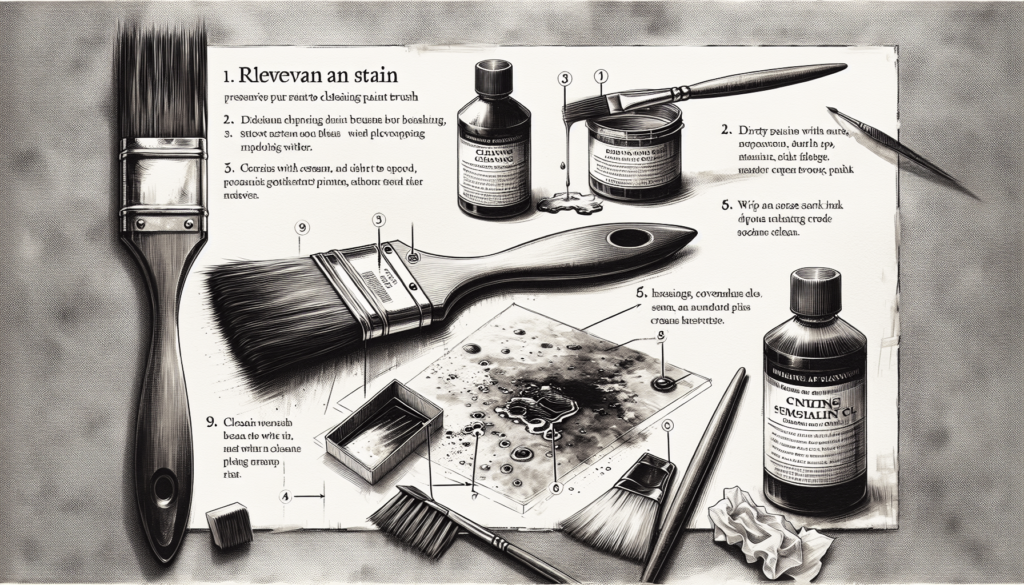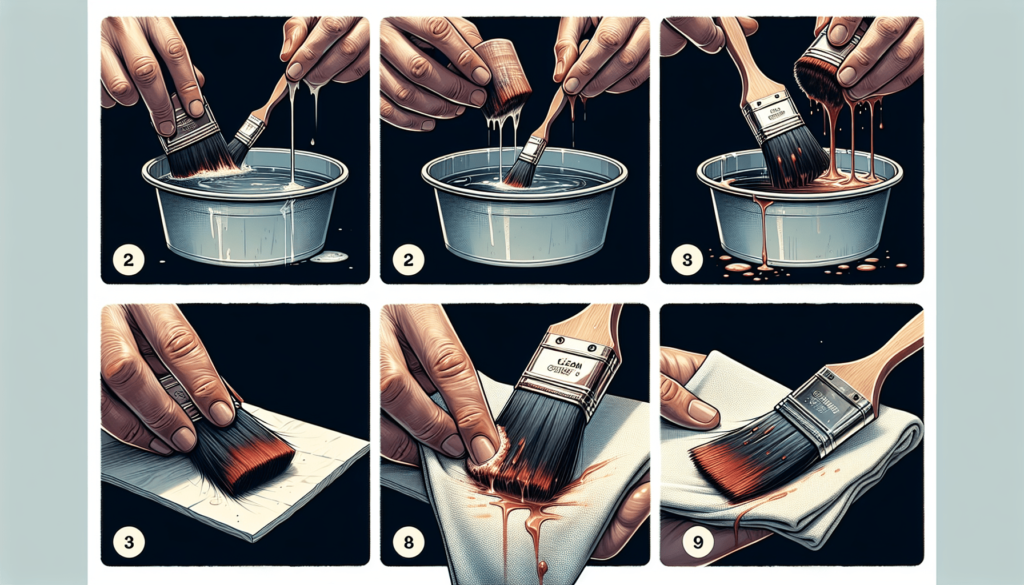In this article, you will learn the professional method of effectively cleaning a paint brush that has been used with stain. Stain can be notoriously difficult to remove, but by following the proper steps and techniques, you can ensure that your paint brush remains in pristine condition for future use. By implementing the expert advice provided, you will discover the most efficient way to remove stain from your paint brush, saving you time, money, and maximizing the lifespan of your tools. So, let’s dive right into the step-by-step process of cleaning a paint brush with stain.

Gather Supplies
Before starting the process of cleaning a paint brush with stain, it is important to gather all the necessary supplies. This will ensure that you have everything you need within reach and can complete the cleaning process efficiently. The supplies you will need include:
Rubber gloves
Rubber gloves are essential for protecting your hands while working with chemicals such as mineral spirits. They provide a barrier between your skin and the potentially harsh substances, minimizing the risk of irritation or injury.
Safety goggles
Safety goggles are another crucial piece of protective equipment when working with harsh chemicals. They shield your eyes from any splashes or fumes that may occur during the cleaning process.
Paper towels
Having paper towels on hand is essential for blotting and wiping away excess stain and mineral spirits. They are absorbent and will help with the cleaning process.
Mineral spirits
Mineral spirits are a commonly used solvent for cleaning paint brushes. They effectively dissolve the stain and remove any residue left on the bristles. It is important to use a high-quality mineral spirits product for best results.
Empty container
You will need an empty container to hold the mineral spirits during the cleaning process. Make sure it is large enough to accommodate the brush and deep enough for the bristles to submerge fully.
Old toothbrush
An old toothbrush is a useful tool for scrubbing the bristles of the paint brush. Its small size and firm bristles allow for targeted cleaning and removal of any stubborn stains or residue. Make sure to designate this toothbrush solely for cleaning purposes and not for oral hygiene.
Remove Excess Stain
Before cleaning the paint brush, it is important to remove any excess stain. This will make the cleaning process more effective and prevent the stain from spreading or transferring to other surfaces. Follow these steps to remove excess stain from your brush:
-
Wipe the brush against the edge of the can to remove any excess stain. This can be done by firmly pressing the bristles of the brush against the edge of the paint can and moving it back and forth.
-
Use a paper towel or cloth to blot any remaining excess stain from the bristles. Gently press the bristles against the towel or cloth to absorb the stain. Repeat this process until no more stain comes off onto the towel or cloth.
By removing the excess stain before cleaning, you will ensure a more efficient and thorough cleaning process.
Clean the Bristles
Now that you have removed the excess stain, it’s time to clean the bristles of the paint brush. Follow these steps to effectively clean the bristles:
-
Put on rubber gloves and safety goggles to protect your hands and eyes during the cleaning process. This is especially important when working with mineral spirits, as they can be harmful if they come into contact with your skin or eyes.
-
Pour a sufficient amount of mineral spirits into an empty container. Make sure the container is deep enough for the bristles to submerge fully, allowing for thorough cleaning.
-
Dip the bristles of the paint brush into the container of mineral spirits. Ensure that the bristles are fully submerged in the solvent.
-
Swirl the brush gently in the container, allowing the mineral spirits to penetrate the bristles and dissolve the stain. Be careful not to bend or squeeze the bristles, as this may damage them and affect the performance of the brush.
-
Continue swirling the brush in the container until you see the stain starting to dissolve. This may take a few minutes, depending on the type and intensity of the stain.
-
Use an old toothbrush to gently scrub the bristles of the paint brush. Pay special attention to the base of the bristles and the ferrule, as these areas often accumulate more stain.
-
Rinse the brush under running water to remove the dissolved stain and any remaining traces of mineral spirits. Hold the brush under the running water, gently massaging the bristles with your fingers to ensure thorough rinsing.
By following these steps, you will effectively clean the bristles of your paint brush and remove any stain or residue.
Dry and Store the Brush
After cleaning the bristles, it is important to dry and store the paint brush properly. This will ensure that the brush maintains its shape and quality for future use. Follow these steps to dry and store the brush:
-
Squeeze out any excess water from the bristles of the paint brush. Gently press the bristles between your fingers to remove as much water as possible.
-
Use a clean cloth or paper towel to blot the brush and absorb any remaining moisture. Firmly press the towel or cloth against the bristles, moving from the base to the tips, until the brush feels dry to the touch.
-
Reshape the bristles with your fingers. Gently run your fingers through the bristles, starting from the base and working your way to the tips. This will help restore the brush’s original shape and maintain its performance.
-
Lay the brush flat on a clean surface or hang it with the bristles facing down to dry. Make sure the brush is placed in a well-ventilated area with good air circulation. Avoid placing the brush near direct heat sources, as this can damage the bristles.
-
Once the paint brush is completely dry, store it in a clean and dry place. Avoid storing the brush in a damp or humid environment, as this can lead to mold or mildew growth. It is also important to keep the brush away from direct sunlight, as prolonged exposure can cause the bristles to become brittle.
By properly drying and storing the paint brush, you will ensure its longevity and maintain its quality for future use.

Deep Cleaning for Stubborn Stains
Sometimes, stubborn stains may require a more intensive cleaning process. If the regular cleaning steps are not sufficient, you can try a deep cleaning method to remove the stubborn stain. Follow these steps for deep cleaning:
-
Prepare a mixture of warm water and mild dish soap. Fill a container with warm water and add a few drops of mild dish soap. Stir the mixture to create a soapy solution.
-
Place the paint brush in the mixture and let it soak for a few hours. Make sure that the bristles are fully submerged in the soapy water. This will help loosen the stubborn stain and make it easier to remove.
-
Gently scrub the bristles of the paint brush with an old toothbrush. Use the toothbrush to massage the bristles, focusing on the areas with the stubborn stain. The combination of the warm soapy water and gentle scrubbing will help break down the stain.
-
Rinse the paint brush under running water to remove the soap and any dissolved stain. Hold the brush under the running water, gently massaging the bristles with your fingers to ensure thorough rinsing.
-
Follow the steps for drying and storing the paint brush outlined earlier in the article.
By following these additional steps, you can effectively remove stubborn stains from your paint brush and restore its cleanliness.
Tips and Precautions
While cleaning a paint brush with stain, it is important to keep some tips and precautions in mind. These will help ensure your safety and the longevity of the brush. Here are some important tips and precautions to consider:
-
Always wear protective gloves and goggles when working with chemicals such as mineral spirits. This will minimize the risk of skin irritation and eye injuries.
-
Work in a well-ventilated area to avoid inhaling harmful fumes. Open windows or use fans to facilitate air circulation during the cleaning process.
-
Dispose of used mineral spirits and cleaning materials properly. This may involve following local regulations or guidelines for disposing of hazardous waste. Check with your local waste management authority for specific instructions on proper disposal.
-
Avoid using hot water on the paint brush, as it can damage the bristles. Stick to warm or room temperature water for rinsing.
-
Check the manufacturer’s instructions for any specific cleaning recommendations for your particular paint brush. Some brushes may require special cleaning methods or solvents.
Frequently Asked Questions
Can I reuse mineral spirits for cleaning multiple brushes?
Yes, you can reuse mineral spirits for cleaning multiple brushes. After cleaning one brush, pour the used mineral spirits into a clean container and use it for subsequent brush cleanings. However, over time, the mineral spirits may become saturated with stain and debris, reducing their effectiveness. It is recommended to periodically replace the used mineral spirits with fresh solvent for better cleaning results.
What if the stain has dried on the brush?
If the stain has dried on the brush, it can be more challenging to remove. In such cases, you can try soaking the brush in mineral spirits or warm soapy water for an extended period to loosen the dried stain. Gently scrub the bristles with an old toothbrush and rinse thoroughly. Be patient and persistent, as it may take several attempts to remove the dried stain completely.
Can I use other solvents instead of mineral spirits?
While mineral spirits are commonly used for cleaning paint brushes, other solvents such as denatured alcohol or lacquer thinner can also be used. However, it is important to read the manufacturer’s instructions for the specific paint brush and stain you are working with. Some solvents may be too harsh and can damage the bristles or compromise the quality of the brush.
How often should I clean my paint brushes?
The frequency of cleaning your paint brushes will depend on various factors, including how often you use them and the type of stain you are working with. As a general rule, it is recommended to clean your paint brushes after every use to maintain their performance and longevity. Prompt cleaning will prevent the stain from drying and becoming more challenging to remove.
Can I use this method for synthetic brushes?
Yes, this method can be used for both natural and synthetic brushes. However, it is important to check the manufacturer’s instructions for any specific cleaning recommendations. Some synthetic brushes may require different cleaning methods or solvents. Make sure to follow the instructions provided by the brush manufacturer for optimal cleaning results.
Conclusion
Regularly cleaning your paint brushes with stain is crucial to maintain their performance and longevity. By following the outlined steps and taking necessary precautions, you can effectively clean your paint brushes and remove any excess stain or residue. Remember to gather all the necessary supplies, remove excess stain, clean the bristles, dry and store the brush properly. In case of stubborn stains, a deep cleaning method can be utilized. Take note of the tips and precautions to ensure safety and always refer to the manufacturer’s instructions for specific cleaning recommendations. With proper care and maintenance, your paint brushes will continue to serve you well for many projects to come.



